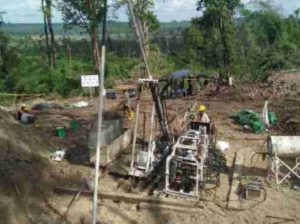How Angkor Gold is showing critics were wrong about Cambodia

Drilling at the Oyadao South Halo Prospect in Cambodia, a joint venture with Jogmec. Source: Angkor Gold Corp.

Angkor Gold Corp. [ANK-TSXV; ANKOF-OTC] operations vice-president JP Dau said Thursday February 1 that he believes 2018 is going to be a stellar year for the company and for Cambodia’s growing mining sector. Angkor has a large land package in Cambodia, covering 1,000 km2. The focus is on project generation and selecting strong partners to advance each of the company’s prospects to a sustainable recurring revenue stream.
“Technical international geologists have described our prospects as a geologist’s paradise, with gold identified across multiple projects, large anomalies of copper and numerous drill targets with each license,” Dau said.
For example, on the 247-km2 Oyadao South License near the Vietnam border Angkor is working with partner Japan Oil, Gas and Metals National Corp. (JOGMEC) to develop a copper-porphyry system known as the Halo project.
Under an agreement, JOGMEC has committed to spend US $3 million on exploration over three years to earn a 51% stake in the Oyadao South License. In January, Angkor said JOGMEC committed to spending an additional $1 million beyond its original 2017 budget to follow up on encouraging copper results from a phase one drilling program at the Halo Project.
Angkor, the project operator, said it will follow up on the results of drill hole HAL17-001D, which returned copper and silver mineralization in the top 99 metres, with anomalous levels of molybdenum corresponding with disseminated sulphides observed in the same interval.
Approximately 1,200 metres of new drilling is planned at Halo in the next two months to drill test newly identified induced polarization targets. Exploration work completed last year clearly indicates that Halo is not the only porphyry target on the property that merits further exploration, the company said.
Meanwhile, Angkor is working with Australia-based gold company Emerald Resources NL [EMR-ASX] on the Koan Nheak License, which covers 189 km2 and is located in the northeast of Mondulkiri Province.
Under an agreement, a Cambodian subsidiary of Emerald can spend US $2 million on exploration and development over two years to earn a 51% participating interest in the license.
Emerald is the owner and operator of the nearby Okvau gold deposit, located 53 km southwest of Koan Nheak. Okvau is currently in its final phase of production permitting and has been granted environmental approvals to proceed.
The project has a published JORC (Australasian Joint Ore Reserves) compliant ore reserve (probable) estimate totalling 14.26 million tonnes, grading 1.98 grams per tonne gold or 907,000 contained ounces.
Angkor said exploration is under way within a recently identified gold-in-soil anomaly to identify drill targets for the next stage of exploration at Koan Nheak’s Peacock Prospect. The company said the gold-in-soils anomaly covers an area of about 1,000 metres and 400 metres in size.
A rock chip sample collected at the Peacock Prospect returned an assay value of 9.94 g/t gold.
“The results at Peacock continue to increase our confidence in the potential of the Koan Nheak,” said Dau. “We are excited that the Peacock gold anomaly is situated in a geological environment very similar to that hosting the Okvau deposit.”
Angkor Gold shares advanced 5.26% or $0.01 to 20 cents in early afternoon trading on Thursday. The 52-week range is 39 cents and 15 cents.
“We were told there were no porphyry systems in Cambodia,” Dau said. “We have proven differently and attracted the interest of several potential partners seeking these formations.”
